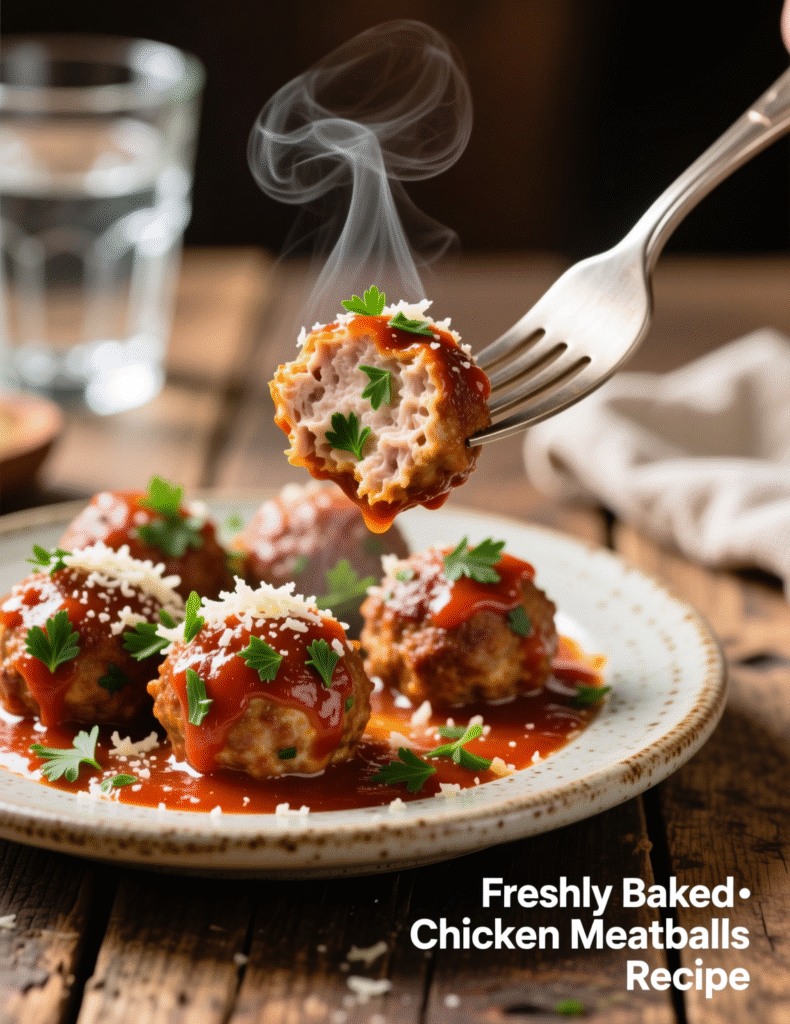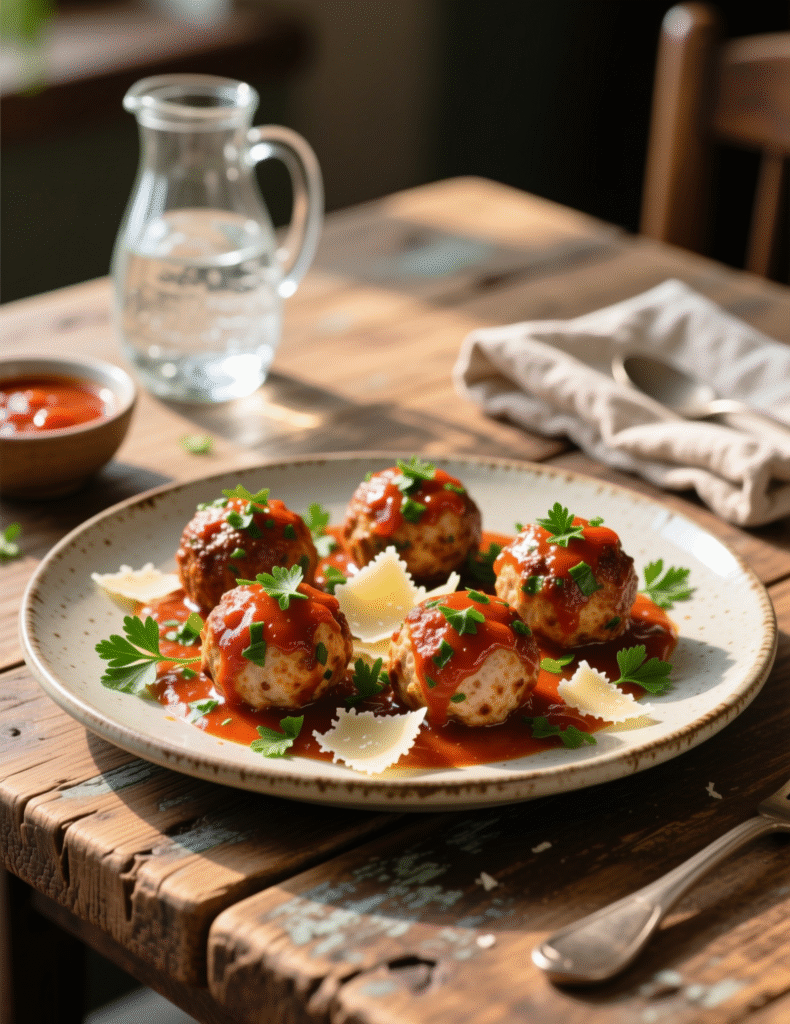When people think of meatballs, chicken usually isn’t the first protein that pops into their head. Beef, pork, or even lamb often take center stage. But chicken meatballs, when done correctly, bring a lighter, juicier, and surprisingly more versatile flavor profile. The trick lies in handling the meat gently, building layers of seasoning, and balancing moisture so the meatballs don’t dry out like old bread left in the sun.
This article dives into the best chicken meatball recipe designed for 4 servings. Not just a list of steps, but a chef’s-level breakdown of what makes them good, how to tweak for different kitchens, and why this dish deserves more respect than it usually gets.
Why Chicken Meatballs Deserve More Attention
Chicken is lean, and lean meats scare a lot of cooks when it comes to meatballs. People assume dry, rubbery, and bland. That’s usually because they overmix, under-season, or skip the fat. Professional kitchens know better. By adding a binder like breadcrumbs and introducing fat—olive oil, egg yolk, or even grated cheese—you create tender bites that hold together without becoming spongy.
There’s also the nutritional side. Chicken meatballs carry less saturated fat compared to beef or pork ones. A 100g portion of ground chicken breast sits at around 165 calories and 9 grams of fat, while ground beef easily pushes double that. For diners watching health metrics, chicken is simply a smarter protein. And yet, it doesn’t feel like a compromise when seasoned with herbs, aromatics, and a sauce that ties it all together.
The Core Recipe for 4 Servings
Ingredients
- 1 lb ground chicken (preferably a mix of breast and thigh)
- 1 large egg
- ½ cup fresh breadcrumbs (panko works better for fluffiness)
- 3 tbsp grated Parmesan cheese
- 2 garlic cloves, finely minced
- 2 tbsp finely chopped parsley
- 1 tsp salt
- ½ tsp freshly cracked black pepper
- ½ tsp paprika (smoked or sweet, depending on preference)
- 1 tbsp olive oil (plus more for cooking)
For the sauce (optional but highly recommended):
- 1 can (14 oz) crushed tomatoes
- 1 small onion, finely diced
- 2 cloves garlic, minced
- 1 tbsp olive oil
- ½ tsp dried oregano
- ½ tsp chili flakes (optional)
- Salt and pepper to taste
Instructions
- Mix the ground chicken with breadcrumbs, egg, Parmesan, garlic, parsley, salt, pepper, and paprika. Use your hands but don’t overwork it. Just fold until it holds together.
- Shape into 16 meatballs, roughly 1.5 inches in size. You don’t need perfect spheres—irregular shapes catch sauce better.
- Heat olive oil in a skillet over medium heat. Sear the meatballs until golden on all sides, about 6–8 minutes. Transfer to a plate.
- In the same skillet, sauté onion and garlic until fragrant. Add tomatoes, oregano, chili flakes, salt, and pepper. Simmer for 10 minutes.
- Drop the meatballs back into the sauce, cover, and simmer gently for another 10 minutes until cooked through. Internal temp should reach 165°F (74°C).
- Serve hot with pasta, rice, or crusty bread.

Technique Insights from the Kitchen
Professional chefs rarely make chicken meatballs with just breast meat. Too lean, too unforgiving. Mixing in thigh meat (or buying pre-ground chicken that already includes it) changes the whole game. Fat equals flavor and also moisture retention.
The breadcrumb-egg-Parmesan trio isn’t just tradition—it’s chemistry. Breadcrumbs act like tiny sponges, holding moisture inside the meatball. Eggs provide structure, while Parmesan delivers umami and saltiness. Without them, the meatball falls apart or tastes one-dimensional.
There’s also a trick many Italian kitchens use: letting the mixture rest for 10 minutes before shaping. This allows the breadcrumbs to hydrate fully, giving the mixture a more cohesive, less sticky texture. It makes rolling the balls faster and less messy.
Flavor Variations
Mediterranean Twist
Swap parsley with mint and dill. Add lemon zest to the mix. Serve with tzatziki instead of tomato sauce.
Asian-Inspired
Mix in ginger, scallions, and soy sauce. Skip Parmesan. Glaze with a teriyaki reduction instead of tomato sauce.
Spicy Kick
Add red chili flakes directly into the meat mix. A spoon of harissa or gochujang blended in gives fire without overwhelming the delicate chicken flavor.
Cooks should never see recipes as rigid. Think of them as frameworks. The chicken meatball is a canvas—you paint flavor depending on what cuisine you want to lean toward.
Common Mistakes and How to Avoid Them
Overmixing is the death of good meatballs. Stir too much and the proteins tighten, leading to dense texture. Mix just enough that ingredients are incorporated.
Cooking on too high heat burns the outside before the inside is safe to eat. A medium flame, steady and patient, ensures golden crust without drying.
Skipping the sauce finish is another mistake. Meatballs simmered briefly in sauce soak up flavor while staying moist. A dry baked meatball isn’t wrong, but it doesn’t hit the same comfort note as one that has been simmered gently in aromatic tomato sauce.
Professional Tips for Consistency
Restaurants often bake meatballs on sheet pans for even cooking. It allows precise control of temperature and frees up stovetop space. You can mimic this by baking at 400°F (200°C) for 20 minutes, then transferring to sauce.
Another pro move is chilling the shaped meatballs for 15 minutes before cooking. This firms them up, so they don’t collapse or flatten in the pan.
If scaling up for events, batch frying is inefficient. That’s when poaching meatballs directly in simmering sauce works better. The sauce becomes infused with chicken flavor, and the meatballs stay impossibly tender.

Pairing Ideas
Chicken meatballs are flexible. Serve with spaghetti for the classic Italian-American approach. Over jasmine rice with soy glaze for Asian fusion. Tucked into pita bread with cucumber yogurt sauce for a Mediterranean street food feel.
For professional catering, smaller bite-size versions work beautifully as hors d’oeuvres. A toothpick, a drizzle of sauce, and suddenly it’s a party favorite. They reheat well too, as long as they’re stored in sauce to prevent drying.
Nutritional Value
A serving of four chicken meatballs (without sauce) averages about 280 calories, 20g protein, and 14g fat. Add the sauce, and you’re closer to 350 calories. Compare that to beef meatballs at nearly 500 calories per similar serving. It’s a leaner option that doesn’t feel light on the palate.
Studies show consumers are increasingly seeking protein-rich but lower-fat dishes. According to a 2023 National Restaurant Association report, 47% of diners said they actively look for leaner protein choices when eating out. Chicken meatballs slot neatly into that demand.
Addressing Misconceptions
One common misconception: chicken meatballs can’t be as flavorful as beef. Flavor isn’t just about the protein. It’s the seasoning, the cooking method, and the sauce that deliver impact. When built properly, chicken meatballs hold just as much character as their beef counterparts, sometimes even more because they let herbs and spices shine through.
Another misconception: breadcrumbs are filler. Wrong. They are structural elements. Without them, the meatball crumbles, and you lose juiciness. The role of starch binders has been studied in food science; they improve water-holding capacity in lean proteins significantly.
Emerging Trends
Globally, chicken meatballs are getting creative. In Nordic kitchens, chefs pair them with lingonberry sauces. In Southeast Asia, ground chicken meatballs end up in brothy soups with lemongrass and lime leaves. Plant-forward restaurants even mix minced vegetables with chicken to hybridize the texture and improve sustainability.
The versatility of chicken meatballs makes them adaptable to nearly any food trend, from keto-friendly plates to global street food mashups. It’s not just a dish. It’s a vehicle for culinary storytelling.
Conclusion
Chicken meatballs don’t deserve the bad reputation of being dry, bland, or second-rate. With the right fat balance, seasoning, and cooking method, they can rival any beef or pork version. For 4 servings, this recipe gives you not only a starting point but also the knowledge to adapt and innovate.
If you’re cooking at home, keep it simple and let the sauce do some heavy lifting. If you’re a professional, think of chicken meatballs as a blank slate—adaptable to any cuisine, dietary preference, or dining style. The best recipes are not just formulas but flexible frameworks. And chicken meatballs, done right, belong in every serious cook’s repertoire.
FAQs
How do I keep chicken meatballs from drying out?
Use a mix of thigh meat, breadcrumbs, and egg to lock in moisture.
Can I bake chicken meatballs instead of frying?
Yes, bake at 400°F for about 20 minutes, then finish in sauce.
What sauce goes best with chicken meatballs?
Tomato sauce is classic, but teriyaki, tzatziki, or lemon butter also pair well.
Are chicken meatballs healthier than beef meatballs?
Yes, they’re leaner with less fat and fewer calories per serving.
Can I make chicken meatballs ahead of time?
Yes, shape and chill them or cook and store in sauce up to 2 days.
Why do my chicken meatballs fall apart?
Usually from skipping binders like egg and breadcrumbs or overmixing.
Can I freeze chicken meatballs?
Yes, freeze cooked meatballs in sauce or uncooked ones on a tray first.
What’s the best size for chicken meatballs?
About 1.5 inches works best for even cooking and tender bites.
Do I have to use Parmesan cheese?
No, but it adds flavor; you can swap with pecorino or skip for dairy-free.
Can I cook chicken meatballs directly in sauce?
Yes, but searing first adds flavor and better texture.

Marie Smith is a passionate recipe blogger, sharing easy, delicious, and creative culinary ideas that inspire home cooks to elevate everyday meals with flavor and simplicity.
